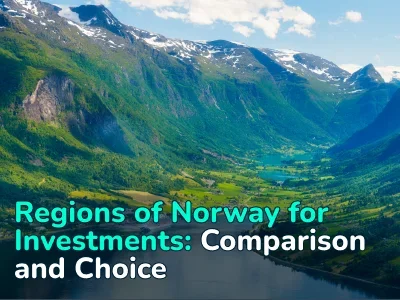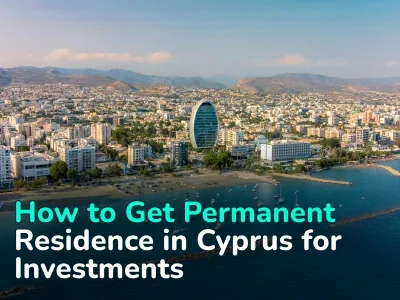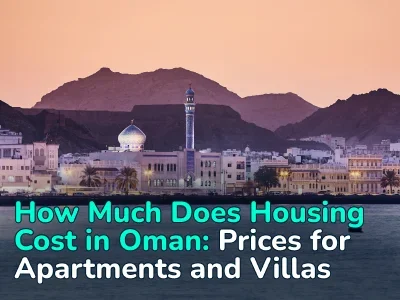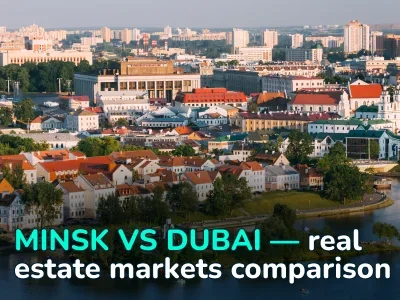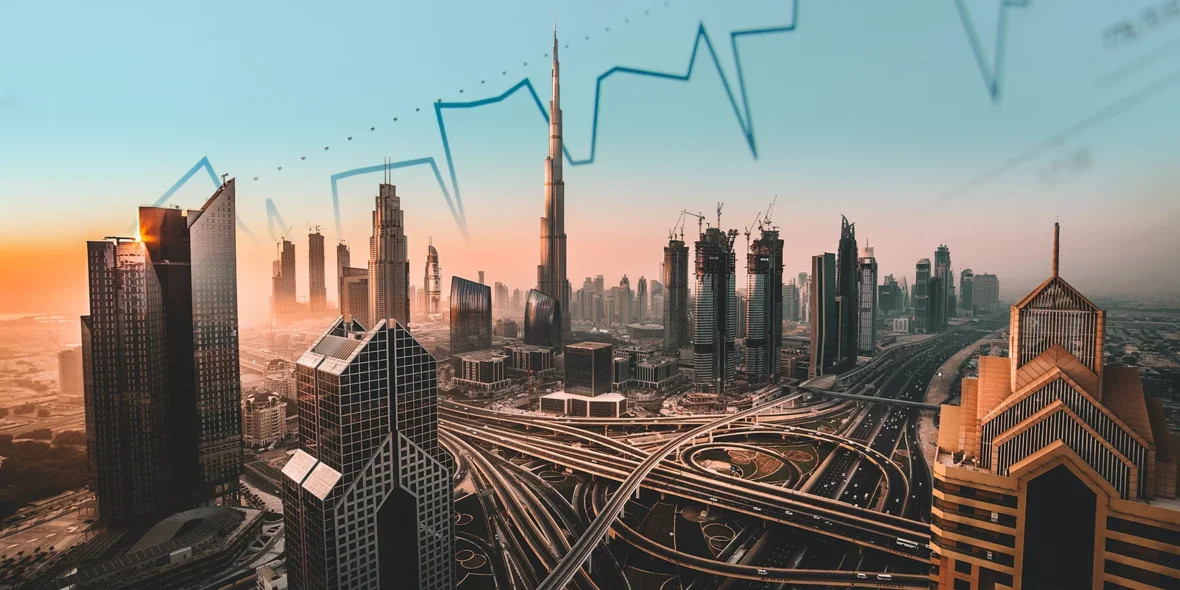
Dubai real estate — smart marketing or profitable investment? Calculating the ROI of the "golden" city. Analytics from REALTING
The news and numerous advertisements are abuzz with headlines about the high investment appeal of Dubai real estate. Dubai is said to be the most profitable city in the world for Airbnb landlords. The emirate also topped the list of cities where international tourists have the biggest expenses. Previously, REALTING analyzed Dubai's real estate buying and selling market. Today, let's see what's happening with real estate rentals right now. And where in the Emirate is the most profitable area to buy real estate for your investment portfolio?
More than 100,000 long-term real estate leases were registered in Dubai every year
When talking about investing in Dubai real estate, most people mean conservative real estate investing, which involves purchasing a property in the primary or secondary markets (without making significant changes to the property) to generate rental income and/or subsequent sale.
Before assessing the investment attractiveness of Dubai, it is necessary to characterize the situation in the rental market. It is worth saying that the government strictly regulates the legislation in the field of real estate rental. Thus, RERA (Real Estate Regulatory Agency – one of the regulatory divisions of the Dubai Land Department) has established that each long-term lease agreement (for a period of 1 year) must necessarily be registered in the EJARI system. The system has undeniable advantages: it allows to control and restrain unreasonable growth of rent, insures against unjustified eviction, and protects the interests of the tenant. Thanks to such registration, the property cannot be rented out twice for the same period of time.
Every year from 2020 to 2022, more than 100 thousand long-term real estate leases were registered in the EJARI system in Dubai. The 2022 figure was the peak year with 124,978 leases, while 2023 is already showing a high value of more than 52 thousand leases.
The years 2016-2018 were distinguished by critically low indicators. Compared to 2015, the number of registered lease agreements in 2016 decreased 9 times – at the same time, 97% of them were concluded in Q1. 2017 sets an anti-record with 1,174 leased properties – a figure down another 7 times compared to the previous period. From Q1 2018, a gradual recovery began.
Reasons for the ups and downs of Dubai's rental market
Labor migration has become one of the most important factors in shaping the demand for rental properties in Dubai. Among other things, it has contributed to transformations in the socio-economic and political spheres. The difference in wages several times between the country of residence and the UAE for most migrants is a determining factor in moving. Foreigners are mainly employed in private companies, while a small number of citizens are employed in the public sector. It is worth noting that Europeans more often come for more skilled and highly paid jobs, forming a demand for renting more expensive and comfortable real estate in prestigious neighborhoods. Migrants from developing countries are employed in jobs that do not require special training related to physical labor. This category of residents considers the most budgetary options for renting housing, in relatively old buildings and often without furniture and appliances.
The downturn in the sales and purchase market in 2016-2019, triggered by falling oil prices and a surplus of supply, also affected the rental market. It became difficult to rent out real estate. In 2016-2018, too high rents played a big role — tenants started to choose neighboring Emirates for their residence more often. This trend was also stimulated by the development of infrastructure and construction outside Dubai, resulting in new jobs. Subsequently, the authorities of Sharjah decided to allow foreigners holding a UAE resident visa to purchase real estate. Legally, the purchase was formalized as a lease agreement for a period of 100 years.
These developments were also reflected in the average rents for the year. Villa rents fell by 9% in 2016, while the apartment segment saw only a slight fluctuation of 1%. The decline continued in 2017, with apartments falling in price significantly more than villas — by 18%. The initial stabilization in the rental market in 2019 was shaken by the coronavirus pandemic. Over the 5 years from 2015 to 2020, average rents for villas and apartments fell by almost 30%.
At the end of 1H 2023, rental prices have yet to reach 2015 levels and averaged over $22k/year for an apartment and over $50k/year for a villa.
Cost of renting a property in different neighborhoods of Dubai
It is important to note that the average figure only gives a general idea of rental properties in Dubai. To have a more detailed understanding it is worth considering rental properties by district. According to the Roads and Transport Authority (RTA) there are 14 official districts in Dubai, which include smaller territorial units.
The table provides information about the average rent in the most popular neighborhoods. Thus, the most expensive areas are: Jumeirah – famous for its beaches, an artificial island, shopping centers and Hadaeq Mohammed Bin Rashid it attracts with the concept of "city in the city", as well as low population density and numerous green areas.
In the Deira area you can find the cheapest options for temporary residence in Dubai. This is one of the oldest districts of the Emirate, that is why the properties that owners offer for rent belong to the old housing stock, mainly Indians, Pakistanis, Malaysians and Iranians rent them.
| Areas | Villas, $/year | Flats, $/year |
|
Jumeira |
65 030 |
37 690 |
|
Hadaeq Mohammed Bin Rashid |
61 520 |
20 750 |
|
Ras Al Khor |
51 370 |
29 170 |
|
Bur Dubai |
44 860 |
12 250 |
|
Dubai Land |
44 720 |
13 290 |
|
Mushrif |
33 440 |
10 790 |
|
Jabal Ali |
29 650 |
12 580 |
|
Deira |
28 680 |
11 070 |
|
Al Wajeha Al Bahriah |
26 710 |
13 170 |
The trend over 10 years is that on average about 80% of rental properties are apartments and the remaining 20% are villas and townhouses.
To determine the feasibility of investing money in real estate in Dubai, it is necessary to determine the investment strategy: it can be, for example, speculative profit on the resale of the property or a relatively small but stable income from renting. In accordance with this it is worth choosing a particular property.
Among tourists who rent accommodation for a short period of time, apartments with a small area – studios and 1-bedroom apartments – are in high demand. Apartments with 2-3 bedrooms are usually chosen by families. Villas more often belong to the segment of elite real estate and become the choice of people with incomes above average, who appreciate increased comfort and privacy.
The location should be chosen based on how long the property will be rented for: for short-term rentals, neighborhoods near tourist attractions and business districts are suitable, for long-term rentals – family communities are a better choice. Infrastructure is also an important factor: the presence of health care facilities, children's educational institutions, retail, catering facilities and food chains, entertainment increase the value of the property. When buying real estate it is necessary to carefully study the master plan of Dubai development to understand what facilities may appear near your investment property.
Information about short-term rentals in Dubai that brokers won't tell you
To better understand how to calculate the investment attractiveness of buying Dubai real estate to rent it out, let's first understand what ROI is. In simple terms, ROI (Return on Investment) is a measure of how much profit an investor has earned, expressed as a percentage of the total value of funds invested in real estate. It is calculated as the ratio of income (after deducting all costs) received from the rental of real estate to its original value. It means the higher the indicator – the more profitable the investment can be considered. ROI calculation allows you to compare the potential profitability of one real estate property with similar options.
ROI is independent of the temporary money value. ROI measures the change in the present value of a property compared to its original cost.
It is important to note that when determining ROI, it would be wrong to multiply the revenue of one month of short-term rental of real estate by 12 months. Renting out a property for daily rent, at first glance, seems more profitable compared to long-term rent, but it implies the presence of a license to operate a hotel or hotel apartments. In this case, owners usually apply to a management company and pay a commission for its services - about 20% of the cost of the rental agreement. The costs of short-term rental include utilities, while in case of long-term rental this part of expenses is paid by the tenant. Thus, when planning investments in real estate for the purpose of renting it out for short terms, potential investors should take into account about 25% of additional costs. Often, however, this information has been concealed by unscrupulous brokers in order to embellish the prospects from the investment. However, since April 2023, the DLD has started fighting fake advertisements and has made it mandatory for all real estate companies to place a QR code in their print and audio-visual advertisements to allow customers to verify the authenticity and validity of the advertisement, ensuring that it has been approved by RERA.
When looking at the average ROI in Dubai, it can be noted that from 2019 to date, the figure for villas is higher by an average of 2% compared to apartments.
At the end of the 1st half of 2023, the following values were established: 6.1% yield for villas and 4.2% for apartments.
The maximum ROI for villas was 7.6% in 2019, at that time the annual rental cost averaged over $41k/year and a villa would have cost an average of $548k to purchase.
Apartments were the most investment-attractive in 2016 – ROI reached 6.5%. It was in this year that the rental cost was the highest for the decade – $24 thousand/year, and buying an apartment would cost an average of $371 thousand.
For villas, the average payback period from 2013 to 2020 was 15 years, and for apartments - 18 years. Since 2021, the payback period has increased for all real estate segments: for villas it increased on average by 2 years and amounted to almost 17 years, and for apartments it increased by 5 years, resulting in 25 years.
ROI by districts in Dubai
Dubai Land is the neighborhood with the highest ROI in 2023 for both villas and apartments. Dubai Land is one of Dubai's most ambitious development projects, where work has been underway since 2003. The neighborhood's 25 projects include villas and apartments, amusement parks, retail, sports and cultural facilities. The infrastructure developed over this time is the center of attraction for both tourists and residents of the Emirate.
Buying an apartment in 2023 in Jabal Ali is likely to pay for itself twice as fast as buying a villa. No wonder – the supply of villas in the coastal area is limited and will be a more exclusive purchase, while apartment buildings are planned to be built much more. In addition to such a trivial Dubai infrastructure element as a large shopping center, residents will appreciate the proximity of the area to Dubai Marina, plus the road to the airport and the capital of the UAE – Abu Dhabi – won’t take more than an hour.
Madinat Al Maktoum started to develop relatively recently – in 2012. Due to the fact that the area is at the stage of construction and development, there is no shortage of supply and profitable options for investment can still be found. In this area ROI for apartments is at the highest level among the rest – 8%, for villas the figure was 5%, ROI period -is about 13 and 18 years respectively.
Bur Dubai apartments are a mix of new residential complexes and older housing stock, which does not always meet the requirements of the buyer. The lowest ROI is a consequence of cheap rents for outdated properties and the high cost of modern properties.
| Villas |
ROI |
|
Dubai Land |
6% |
|
Hadaeq Mohammed Bin Rashid |
6% |
|
Deira |
6% |
|
Mushrif |
5% |
|
Madinat Al Maktoum |
5% |
|
Jumeira |
4% |
|
Jabal Ali |
3% |
| Flats |
ROI |
|
Madinat Al Maktoum |
8% |
|
Dubai Land |
7% |
|
Hadaeq Mohammed Bin Rashid |
7% |
|
Mushrif |
7% |
|
Jabal Ali |
6% |
|
Zaabeel |
5% |
|
Ras Al Khor |
4% |
|
Jumeira |
3% |
|
Bur Dubai |
2% |
When making investment decisions, one should take into account a possible surplus of supply if there is a loss of interest in the country on the part of foreign nationals. In this case, 8% of UAE citizens will not be able to meet the demand for the huge amount of real estate built. It is worth paying attention to the prospects of tightening tax legislation.
The UAE government has created a favorable investment climate, and as a consequence, many companies open and relocate their businesses here, creating new jobs. All this stimulates economic growth, and as a consequence, the real estate market. Ensuring and increasing transparency in the real estate sector, as well as strict regulation of legislation through information technology ensures a low level of risk on the part of the government and makes the market attractive to investors.
Returning to the question at the beginning, it is worth saying that investing in Dubai real estate should be approached with a "cold" head. The Dubai market is indeed a subject to aggressive advertising by real estate organizations, but with careful study of all aspects and the selection of a suitable property it is possible to increase your capital significantly .
The database of registered real estate lease contracts in Dubai is based on information from Dubai Land Department (DLD).
Author
Providing readers with quality analysis on global trends in the real estate market.












